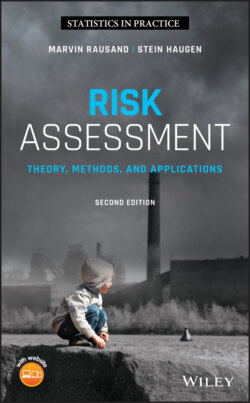Читать книгу Risk Assessment - Marvin Rausand - Страница 69
2.3.9 Terminology Comments
ОглавлениеThis section has defined a number of commonly used terms in risk assessment. The purpose is to establish a terminology that helps to describe different elements of the problem being addressed in a risk analysis. Unfortunately, as stated already, terminology is a problem within this field. Therefore, we once more warn the reader about the use of these terms in other documents, reports, standards, and scientific publications.
All the terms defined in this section are used in different ways by different authors. In particular the terms “hazard,” “initiating event,” and “hazardous event” are used in many different ways compared to how it has been defined here. Hazard is often used to encompass both hazardous events and enabling events and conditions. Hazard then becomes a term that covers more or less anything that either are events in accident scenarios or conditions that can influence the development of those scenarios. This may be sufficient in some cases, but we see that it can cause confusion and result in an unstructured process to identify what can go wrong. Our opinion is therefore that it is important to have precise definitions. To illustrate the above, an example of what a checklist for hazard identification can look like is shown in Table 2.5 . If this list is compared to the definitions, it contains both hazards, enabling events and enabling conditions.
Table 2.5 Generic hazard list (not exhaustive).
| Mechanical hazard– Kinetic energy– Acceleration or retardation– Sharp edges or points– Potential energy– High pressure– Vacuum– Moving parts– Rotating equipment– Reciprocating equipment– Stability/toppling problems– Degradation of materials (corrosion, wear, fatigue, etc.) Hazardous materials– Explosive– Oxidizing– Flammable– Toxic– Corrosive– Carcinogenic Electrical hazards– Electromagnetic hazard– Electrostatic hazard– Short circuit– Overload– Thermal radiation Thermic hazards– Flame– Explosion– Surfaces with high or low temperature– Heat radiation Radiation hazards– Ionizing– Nonionizing | Noise hazards– External– From internal machines Hazards generated by neglecting ergonomic principles– Unhealthy postures or excessive effort– Inadequate local lightning– Mental overload or underload, stress– Human error, human behavior– Inadequate design or location of visual display units Environmental hazards– Flooding– Landslide– Earthquake– Lightning– Storm– Fog Organizational hazards– Inadequate safety culture– Inadequate maintenance– Inadequate competence– Inadequate crowd control Sabotage/terrorism– Cyber threat– Arson– Theft– Sabotage– Terrorism Interaction hazards– Material incompatibilities– Electromagnetic interference and incompatibility– Hardware and software controls |
To add to the confusion, several other terms are used that overlap our terms, but often without a clear definition. Examples include accident initiator, accident initiating event, accidental event, critical event, undesired event, unwanted event, process deviation, and potential major incident (accident).
